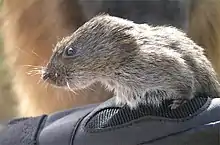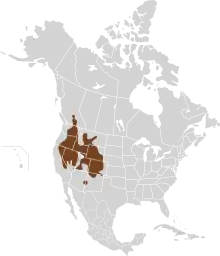Montane vole
The montane vole (Microtus montanus) is a species of vole native to the western United States and Canada.[1]
| Montane vole | |
|---|---|
 | |
| Scientific classification | |
| Domain: | Eukaryota |
| Kingdom: | Animalia |
| Phylum: | Chordata |
| Class: | Mammalia |
| Order: | Rodentia |
| Family: | Cricetidae |
| Subfamily: | Arvicolinae |
| Genus: | Microtus |
| Subgenus: | Pitymys |
| Species: | M. montanus |
| Binomial name | |
| Microtus montanus (Peale, 1848) | |
 | |
Description
Montane voles are medium-sized voles, with a total length of 14 to 22 cm (5.5 to 8.7 in), including the 2 to 7 cm (0.79 to 2.76 in) tail. Adults typically weigh anything from 37 to 85 grams (1.3 to 3.0 oz), with males being slightly larger than females, but the actual weight varies considerably with age, geography, and subspecies. The upper body is covered with fur of a dark brownish shade, again with some variation between individuals. The fur is paler on the flanks, and fades to grey or white on the underparts. The tail exhibits the same color variation, with the fur being dark brown to almost black on the upper surface and grey or white below.[2]
Montane voles possess scent glands on the hips, near the anus, and on the male genitalia. These glands increase in size in response to testosterone, and are therefore particularly large in adult males.[3] At least some of these glands produce unique fatty acid esters, that may function in species recognition.[4] Females have four pairs of teats, running from the chest to the groin.[2]
Distribution and habitat
Montane voles are found in mountainous and other high elevation terrain in the western United States and Canada.[5] Within this region they are generally found in drier climates than other species of vole, and in areas more dominated by grassland than by shrubs.[2][6] Typical habitats include alpine meadows and grassy areas near streams or lakes; they are also often found in cropland or pasture.[1] Fossils of montane voles have been recovered from as far back as the Irvingtonian, when they appear to have been more widespread across what is now the southwestern United States.[2]
At least fourteen subspecies of montane vole are recognized:[2]
- M. m. montanus - eastern California and southern Oregon
- M. m. arizonensis - eastern Arizona and western New Mexico
- M. m. canescens - central Washington and southern British Columbia
- M. m. codiensis - north western Wyoming
- M. m. dutcheri - central California
- M. m. fucosus - southern Nevada
- M. m. fusus - southern Colorado
- M. m. micropus - northern Nevada
- M. m. nanus - widespread, from Washington and Oregon to Montana and Colorado
- M. m. nevadensis - south western Nevada
- M. m. pratincola - north western Montana
- M. m. rivularis - southern and eastern Utah
- M. m. undosus - central Nevada
- M. m. zygomaticus - north eastern Wyoming
Biology and behavior
Montane voles are herbivorous, although they may also eat small numbers of insects and other arthropods. The majority of their diet consists of forbs, supplemented by seeds, grasses, and fungi. One study in Colorado found that favored foods included vetch and evening primrose.[7] Predators include a range of hawks and owls, weasels, and even coyotes.[2] Montane voles have been reported to form up to 80% of the diet of great horned owls in Idaho.[8]
Montane voles have also been used in the laboratory in studies of African sleeping sickness, since they suffer similar symptoms to humans when infected with the parasite.[2]
Montane voles are nocturnal during the summer, but primarily diurnal during winter.[9] They often inhabit abandoned gopher burrows, although they are also capable of digging their own.[10] Typical burrows are 100 cm (39 in) in length, and reach a depth of 20 cm (7.9 in), although there is considerable variation.[2] Montane voles also construct nests, which are typically cup-shaped,[10] although those used for raising young are globular and about 13 cm (5.1 in) in diameter.[11] Males mark their territory with urine and dung and by rubbing their anal scent glands along the ground.[12]
Reproduction
The breeding season begins in April or May, and continues until at least August.[13] The start of the season is triggered by chemicals found in fresh spring grass,[14] and coincides with the snowmelt. Since chemicals in older, late summer grass, depress the reproductive drive, the exact end of the season may vary from year to year, and some individuals have been reported to breed in midwinter in recent decades.[2]
Males mate with multiple females if the opportunity arises,[15] and have no preference for unmated females over those that have previously mated.[16] Females do not have regular estrus cycles,[17] and their reproductive status is apparently induced by chemical signals from nearby males.[18]
Gestation lasts 21 days, and results in the birth of five to eight pups.[19] The young are born blind and helpless, and are not capable of standing until four days after birth, around the time that they first begin to develop fur. Their eyes open after about ten days, and they are weaned at around fourteen days.[20] The pups leave the nest a day or so after weaning, when the female begins to prepare for a new litter.[19]
The female may raise three to four litters in a year. Young born early in the year may reach sexual maturity in as little as four weeks, but those born in the fall do not do so until spring.[21]
References
- Cassola, F. (2016). "Microtus montanus". IUCN Red List of Threatened Species. 2016: e.T42630A22346732. doi:10.2305/IUCN.UK.2016-2.RLTS.T42630A22346732.en. Retrieved 12 November 2021.
- Sera, W. & Early, C.N. (2003). "Microtus montanus". Mammalian Species. 716: 1–20. doi:10.1644/716. S2CID 198125949.
- Jannett Jr., F.J. (1978). "Dosage response of the vesicular, preputial, anal, and hip glands of the male vole, Microtus montanus, to testosterone propionate". Journal of Mammalogy. 59 (4): 772–779. doi:10.2307/1380141. JSTOR 1380141. PMID 374664.
- Welsh, C.J.; et al. (1988). "Novel, species-typical esters from preputial glands of sympatric voles, Microtus montanus and M. pennsylvanicus". Journal of Chemical Ecology. 14 (1): 143–158. doi:10.1007/BF01022538. PMID 24277001. S2CID 13011215.
- "Montane Voles | Vole Control". www.volecontrol.com. Retrieved 2018-10-01.
- Stoecker, R.E. (1972). "Competitive relations between sympatric populations of voles (Microtus montanus and M. pennsylvanicus)". Journal of Animal Ecology. 41 (2): 311–329. doi:10.2307/3471. JSTOR 3471.
- Vaughan, T.A. (1974). "Resource allocation in some sympatric, subalpine rodents". Journal of Mammalogy. 55 (4): 764–795. doi:10.2307/1379407. JSTOR 1379407.
- Marti, C.D. & Kochert, M.N. (1996). "Diet and trophic characteristics of great horned owls in southeastern Idaho". Journal of Field Ornithology. 67 (4): 499–506. JSTOR 4514149.
- Rowsemitt, C.N. (1991). "Activity rhythms in female montane voles (Microtus montanus)". Canadian Journal of Zoology. 69 (4): 1071–1075. doi:10.1139/z91-151.
- Jannett Jr., F.J. (1982). "Nesting patterns of adult voles, Microtus montanus, in field populations". Journal of Mammalogy. 63 (3): 495–498. doi:10.2307/1380450. JSTOR 1380450.
- Hartung, T.G. & Dewsbury, D.A. (1979). "Nest-building behavior in seven species of muroid rodents". Behavioral and Neural Biology. 27 (4): 532–539. doi:10.1016/S0163-1047(79)92166-6.
- Jannett Jr., F.J. (1981). "Sex ratios in high-density populations of the montane vole, Microtus montanus, and the behavior of territorial males". Behavioral Ecology and Sociobiology. 8 (4): 297–307. doi:10.1007/BF00299530. S2CID 45567478.
- Negus, N.C.; et al. (1992). "Phenotypic plasticity of the montane vole (Microtus montanus) in unpredictable environments". Canadian Journal of Zoology. 70 (11): 2121–2124. doi:10.1139/z92-285.
- Berger, P.J.; et al. (1981). "Chemical triggering of reproduction in Microtus montanus". Science. 214 (1): 69–70. Bibcode:1981Sci...214...69B. doi:10.1126/science.7025210. PMID 7025210.
- Shapiro, L.E. & Dewsbury, D.A. (1990). "Differences in affiliative behavior, pair bonding, and vaginal cytology in two species of vole (Microtus ochrogaster and M. montanus)". Journal of Comparative Psychology. 104 (3): 268–274. doi:10.1037/0735-7036.104.3.268. PMID 2225765.
- Ferguson, B.; et al. (1986). "Male preferences for unmated versus mated females in two species of voles (Microtus ochrogaster and M. montanus)". Journal of Comparative Psychology. 100 (3): 243–247. doi:10.1037/0735-7036.100.3.243.
- Gray, G.D.; et al. (1974). "Oestrus and induced ovulation in montane voles". Journal of Reproduction and Fertility. 38 (1): 193–196. doi:10.1530/jrf.0.0380193. PMID 4858275.
- Sawrey, D.K. & Dewsbury, D.A. (1991). "Males accelerate reproductive development in female montane voles". Journal of Mammalogy. 72 (3): 343–346. doi:10.2307/1382105. JSTOR 1382105.
- McGuire, B. & Novak, M. (1986). "Parental care and its relationship to social organization in the montane vole (Microtus montanus)". Journal of Mammalogy. 67 (2): 305–311. doi:10.2307/1380883. JSTOR 1380883.
- Shapiro, L.E. & Insel, T.R. (1990). "Infant's response to social separation reflects adult differences in affiliative behavior: a comparative developmental study in prairie and montane voles". Developmental Psychobiology. 23 (5): 375–393. doi:10.1002/dev.420230502. PMID 2253816.
- Negus, N.C.; et al. (1986). "Microtine population dynamics in a predictable environment". Canadian Journal of Zoology. 64 (3): 785–792. doi:10.1139/z86-117.
